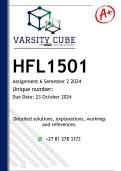HFL1501
Assignment 6 Semester 2 2024
Unique number:
Due Date: 23 October 2024
Detailed solutions, explanations, workings
and references.
+27 81 278 3372
, QUESTION 1
1.1.
The 1961 Constitution of South Africa (establishment of the Republic of South
Africa) is an example of a constitution that embraced an approach of complete
denial of the principle of constitutionalism. This constitution allowed for
parliamentary supremacy, where the legislature had virtually unchecked power, and
there was no higher legal authority to restrain or review the actions of Parliament.
1.2.
The current South African governmental structure is based on constitutional
supremacy rather than parliamentary supremacy. Here are key provisions from
the Constitution of the Republic of South Africa, 1996 that demonstrate this:
1. Section 1(c): This section declares that South Africa is founded on the
supremacy of the Constitution and the rule of law, meaning all laws and
actions by the government must comply with the Constitution.
2. Section 2: The Constitution explicitly states that it is the supreme law of the
Republic. Any law or conduct inconsistent with the Constitution is invalid,
and the obligations imposed by the Constitution must be fulfilled.
3. Section 165(2): This section underscores the independence of the judiciary,
stating that courts are independent and subject only to the Constitution and
the law, meaning even parliamentary decisions are subject to constitutional
review by the courts.
4. Chapter 8 (Sections 167-172): The powers of the Constitutional Court allow
for judicial review of laws passed by Parliament. The Constitutional Court
has the authority to strike down laws or executive actions that are
unconstitutional.
Varsity Cube 2024 +27 81 278 3372




